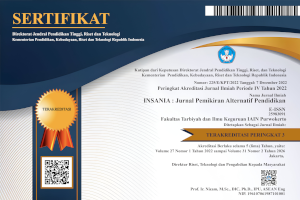Belajar Berfilsafat Melalui Lirik Tembang
DOI:
https://doi.org/10.24090/insania.v12i1.219Kata Kunci:
song lyrics, literary work, philosophy, hermeneutics, semiotics, and esthetics .Abstrak
In this paper song lyrics are seen as a literary work. They are identical in nature to poems. However, to most of us, song lyrics are more familiar than poems. This paper argues that by appreciating songs (lyrics) one’s philosophical power becomes trained. Its content, that is quite often rich in hermeneutics (related to interpretation), semiotics (related to symbols) and esthetics (related to arts, beauty) – some of the approaches to philosophy, might be responsible for this. For illustrations, four selected, analysed song lyrics have been presented here.Unduhan
Referensi
Djojosuroto, Kinayati. 2006. Filsafat Bahasa. Yogyakarta: Penerbit Pustaka.
Gee, J.P. 1993. An Introduction to Human Language: Fundamental Concepts in Linguistics. New Jersey:
Prentice-Hall, Inc.
Hardiman, F.B. “Hermeneutik: Apa Itu?â€. Dalam Majalah Kebudayaan Umum Basis, XL, No. 1, Januari
1991.
Lado, Robert. 1957. Linguistics across Cultures: Applied Linguistics for Language Teachers. Ann Arbor: The
University of Michigan Press.
Pradopo, R.D. “Pemaknaan Puisi†(Disampaikan pada Pembukaan Kuliah Program Pascasarjana
Universitas Gadjah Mada Semester II Tahun Akademik 1993/1994, 2 Februari 1994).
Salkie, Raphael. 1995. Text and Discourse Analysis. New York: Routledge.
Satoto, Soediro. 1993. Kajian Drama. Surakarta: STST Press.
Setyawan, P.T. 2004. Daun Berserakan: sebuah Renungan Hati. Jakarta: PT. Gema Insani Press.
van Zoest, Aart. 1978. Semiotika: tentang Tanda, Cara Kerjanya dan Apa yang Kita Lakukan dengannya
(versi terjemah oleh Ani Soekowati). Jakarta: Yayasan Sumber Agung.
. 1980. Fiksi dan Nonfiksi dalam Kajian Semiotik (versi terjemahan oleh Manoekmi Sardjoe).
Jakarta: Intermasa.
Unduhan
Cara Mengutip
Terbitan
Bagian
Lisensi
Authors who publish with this journal agree to the following terms:
Authors retain copyright and grant the journal right of first publication with the work simultaneously licensed under a Creative CommonsAttribution-ShareAlike License that allows others to share the work with an acknowledgment of the work's authorship and initial publication in this journal.
Authors are able to enter into separate, additional contractual arrangements for the non-exclusive distribution of the journal's published version of the work (e.g., post it to an institutional repository or publish it in a book), with an acknowledgment of its initial publication in this journal.
Authors are permitted and encouraged to post their work online (e.g., in institutional repositories or on their website) prior to and during the submission process, as it can lead to productive exchanges, as well as earlier and greater citation of published work (See The Effect of Open Access).








